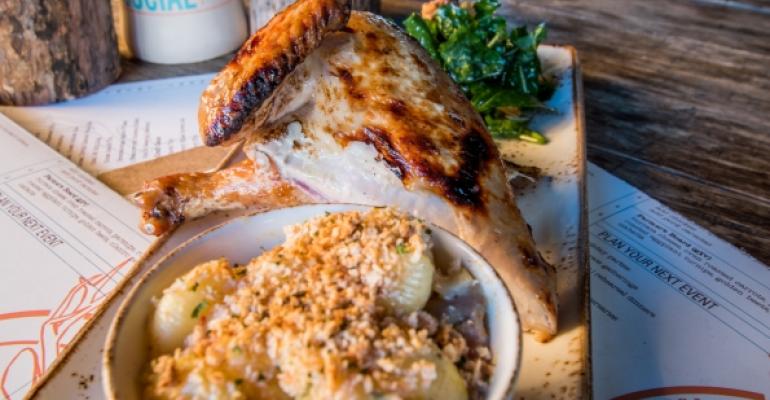Some chefs are buzzing about coffee and tea, and not just because of caffeine. They get a kick out of creating special flavoring effects by poaching, brining, marinating and even smoking foods with these staple beverage products.
Novel culinary creations like coffee-poached eggs and tea-brined chicken appeal to the large and growing corps of specialty coffee and tea aficionados. Coffee sales in the U.S. topped $48 billion in 2014, with more than three-quarters of the total sold in foodservice, says the market research firm Packaged Facts. Tea is huge as well, with more than 80 billion servings consumed in America last year, reports the Tea Association of the U.S.A. Thus it is no surprise that coffee is an ingredient on nearly 21 percent of restaurant menus, according to the market research firm Datassential. Culinarians are undoubtedly tinkering with tea too.
“Cooking with tea and coffee, and alcoholic beverage programs with tea and coffee, are surging right now all over the country,” declares Sergio Romero, culinary director of Punch Bowl Social, a six-unit dining and entertainment concept in the Denver-based Seasoned Development restaurant group.
Paul Bunyan’s Sweet Tea Brined Chicken is Punch Bowl Social’s best-selling center of the plate menu item. For 24 hours prior to roasting, the hefty chicken half is soaked in a brine of premium black tea leaves, water, salt, lemon, thyme, simple syrup and agave syrup. “The brine is like a big pot of culinary tea,” Romero says. “We use a lot of tea in our punches, so doing this is kind of a no-brainer.”
The payoff for the brining is “a super moist chicken, beautifully golden, with super crispy chicken skin,” Romero says. “And you can taste the difference. It has undertones of earthiness and a prominent flavor of black tea.”
Another proponent of flavoring savory and sweet cuisine with brewed beverages is Michael Taus, chef-owner of Taus Authentic, a contemporary American dining spot in Chicago.
“The coffee and tea that restaurants are serving today is so much better now than it was years ago,” says Taus, a veteran of the Chicago dining scene for more than two decades. “It is better appreciated now, and I think that’s why it is becoming more relevant in cooking.”
A Taus signature dessert, To Be Named Chocolate Cake, showcases housemade Turkish coffee ice cream. The frozen treat is inspired by the traditional Turkish coffee formula of finely ground coffee, sugar, fresh cardamom and water, brought to a boil three times in a small pot. Taus makes it with a dairy mixture flavored with reduced espresso and cardamom. “People are quite intrigued by the flavor,” he says.
Recently, Taus riffed on redeye gravy, a traditional Southern pan sauce made by stirring brewed coffee into the pan drippings from fried ham. His interpretation was a pork chop with pineapple fried rice drizzled with an Asian-inspired redeye gravy, cooked with roasted ham, pineapple and ginger and deglazed with espresso.
Over the years, Taus has also smoked duck breast with tea leaves, poached fish fin in a broth of jasmine tea pearls, lemongrass and ginger, spiked mole sauce with brewed coffee and crafted chai flavoring syrups.
At La Sirena Clandestina, a Latin-American restaurant in Chicago, Coffee French Toast, Coffee-Cured Foie Gras Torchon, and Coffee-Smoked Whitefish headlined a unique Sunday brunch event last year featuring 12 menu choices made with coffee.
In the Coffee French Toast, a batter of brewed espresso, condensed milk and eggs “really sent the coffee flavor coming through,” says chef Mark Steuer. Rolling the foie gras in freshly ground espresso prior to cooking gave it a crunchy exterior and a roasty flavor that was a pleasing counterpoint to the rich, buttery duck liver.
In other brunch highlights, eggs poached in brewed coffee were tinged with caramel and nuanced with java, and coffee beans tossed into the smoker subtly perfumed whitefish served on a bagel.
“It was a fun exercise cooking those dishes, pushing ahead with everything you can do with coffee,” says Steuer.
In a workshop for restaurant operators at the 2015 National Restaurant Association Show, Steuer showed off a dry rub for pork made with espresso, salt and brown sugar. The brown sugar lends a caramelized, crunchy crust to the pork as it roasts, while the java adds flavoring notes.
“A coffee rub gives you a really dark, roasted flavor profile without the risk of overcooking the protein,” says Steuer. “It’s a great way to add depth of flavor.”





